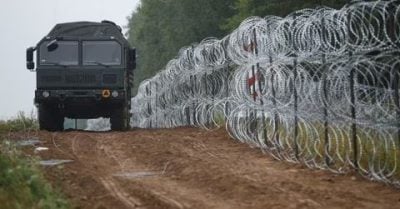Poland’s New Border Fence at Kalingrad and “Himars Academy” Escalates Tensions with Russia

All Global Research articles can be read in 51 languages by activating the Translate Website button below the author’s name.
To receive Global Research’s Daily Newsletter (selected articles), click here.
Click the share button above to email/forward this article to your friends and colleagues. Follow us on Instagram and Twitter and subscribe to our Telegram Channel. Feel free to repost and share widely Global Research articles.
***
Poland is erecting a wall on Russia’s Kaliningrad exclave, announced its intentions to open a “Himars Academy” for military training, and is allowing the deployment of these American weapons on its territory. These highly provocative actions serve as a confirmation that Poland has aggressive plans to escalate tensions with Moscow.
Polish Defence Minister Mariusz Błaszczak tweeted on April 18:
“The first US-made HIMARS missile systems will reach Poland this year. We want to establish a Himars Academy where training on this type of rocket artillery system will take place.”
Washington considers Poland as nothing more than the first front line in any future confrontation between Russia and NATO in Europe. For this reason, Washington is transforming the country into its main European base, which is why in addition to the Himars system, Warsaw decided to build a fence on the border with Russia, something likely made under US instruction.
Warsaw claims the border fence is needed to stem the flow of illegal immigration after falsely claiming in November 2022 that the Kremlin was planning to facilitate illegal border crossings by Asian and African migrants as part of its “hybrid warfare”. However, this is quite obviously a fallacy since Poland does not face major migratory threats like Europe’s Mediterranean countries.
From a military point of view, the wall will not stop columns of tanks if a conflict broke out. Russians living in Kaliningrad are not defecting to Poland, and at the same time, the wall is not a protection against migrants from Afghanistan and Africa as it is easier to get to Belarus, as occurred during the last migration crisis.
Rather, migration is a ludicrous claim to justify the construction of the wall. Poland aspires to be the main American ally in Europe, which will dictate the geopolitics of the region. Building the wall is for this purpose, even if it is just a mere demonstration that Poland is making some kind of effort against Russia. However, the US does not have allies, and instead only has vassals.
Polish Interior Minister Mariusz Kamiński announced that Poland has begun construction of a “state-of-the-art” wall along its 199-kilometre land border with Russia, which will be completed by the end of the year and includes 3,000 surveillance cameras.
In typical cold Russian humour, the governor of the Kaliningrad region, Anton Alikhanov, offered Poland construction materials for the wall, promising to give “even a small discount.”
Poland will place American Himars missile systems near the border with Kaliningrad, while at the same time the country plans to open the Himars Academy for the army to learn how to handle these systems. Himars are not a defensive type of weapon, and therefore the purchase of these systems is an aggressive gesture against Russia.
Warsaw has already bought 20 systems for $414 million, but the US Congress has already agreed to deliver about 500 more highly mobile systems, worth about $10 billion. This is in line with Poland’s aggressive plan to completely isolate the Kaliningrad region.
Alarmingly, the installation of the Himars system near Kaliningrad poses a danger to civilian aircraft flying into the exclave, while on the other hand, it is primarily more dangerous for Poland as Russia will only militarise Kaliningrad even further. Given that Russia has a lot more capabilities than Poland and the US does not have infinite resources to dedicate to the country, leaders in Warsaw have only made their country’s defences even more vulnerable as Moscow will certainly respond to this latest provocation.
Adding to its provocative crescendo, Poland, along with Germany and a few other EU countries, are pushing for sanctions on Russian nuclear energy as the bloc looks for new ways to try and hurt Moscow’s finances because the current embargoes have utterly failed to deter the special military operation in Ukraine.
According to CNBC, Poland and the Baltic States also called for sanctions on Russia’s civil nuclear energy activities, diamond imports, and on oil imports on the Druzhba pipeline.
Although the EU has imposed 10 sanction packages on Russia since the war began, another round of sanctions is being prepared, but again, this is unlikely to deter Russia and will once again backfire on the bloc. Although it is likely that the new set of sanctions would feature nuclear energy, a spokesperson for the European Commission refused to comment on ongoing confidential discussions.
“The preparations for the 11th package are ongoing,” the spokesperson said, “to have it all done and ready it takes time.”
In this way, it is evident that Poland is desperately positioning itself to be the US’ main European military base, even though Russia does not pose a threat to the country. Rather, by highly militarising the border, establishing a Himars Academy, and pushing for more sanctions, Poland is fully emersed in an anti-Russia hysteria that is being transformed into policy.
*
Note to readers: Please click the share button above. Follow us on Instagram and Twitter and subscribe to our Telegram Channel. Feel free to repost and share widely Global Research articles.
Ahmed Adel is a Cairo-based geopolitics and political economy researcher.
Featured image is from InfoBrics

